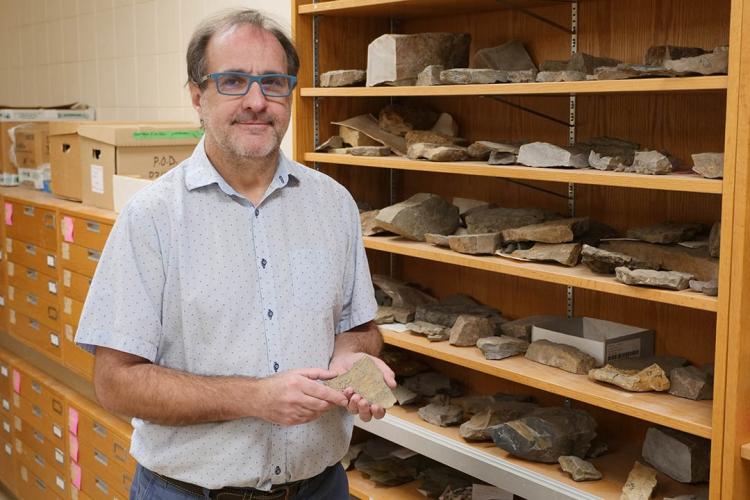Small, palm-sized rocks litter the countertops in a lab in the University of Saskatchewan's (USask) Department of Geology. Spiral patterns and near-perfect interlocking hexagons are etched into the surface of so many rocks.
Dr. Luis Buatois (PhD) traces a series of hexagons with his finger, following the path carved by tiny organisms millions of years ago that have long since left these unique fossils in their wake.

Dr. Luis Buatois (PhD) shows off a mold of a hexagonal trace fossil from the ocean depths. (Photo: Matt Olson)
It's those patterned trace fossils - fossils not of organisms themselves, but the remnants they leave behind like millimetre-sized burrows - that Buatois and his team explore in their newest paper published in The Proceedings of the National Academy of Sciences (PNAS) and may hold the key to understanding the evolution of these fascinating communities among living organisms.
"What we have seen here is how this deep marine ecosystem was constructed through time," Buatois said. "We are trying to look at the timing of innovation; track the origin for modern deep-sea communities."
A professor in the Department of Geological Sciences in the College of Arts and Science and an adjunct professor in biology, Buatois' interest is in the intersection of environments and life - specifically, what these rocks can teach us about the evolutionary history of animals. These hexagonal trace fossils were meant to be tiny bacteria farms for ancient organisms. As ocean currents pushed water down across deep-sea sediment, they provided oxygen used by bacteria growing within these burrows.
Buatois and his team catalogued fossil information between 635 and 359 million years old from more than 700 locations around the world through work in the field and examination of museum collections and literature. The establishment of these bacterial farms is indicative of the presence of communities of organisms plotting strategies to feed in an otherwise food-scarce environment, eventually leading to the proliferation and colonization by such organisms in more and more ocean areas around the world.
"From our database, we know when those burrows became much more common," he said.
Through this research, Buatois and his team can also map out where these innovative behaviours first emerged and how they expanded as the Earth evolved over hundreds of millions of years, with continents and oceans changing positions.
The fossil database will also be a resource for future researchers around the world continuing to investigate ancient ecosystems through trace fossils.
"When you look at the story we have with respect to evolutionary changes, it's pretty much based on shallow marine environments. With this kind of work, we are moving into a remote environment, far from our everyday experience, and well known for the scarcity of body fossils," Buatois said. "It's like opening a window into the history of an environment that has only been marginally explored. We are just scratching the surface."
The research team for this project is deeply rooted in USask. Alongside Buatois, co-authors include Dr. M. Gabriela Mángano (PhD), USask professor in the Department of Geological Sciences and adjunct professor in biology; Dr. Maximiliano Paz (PhD), professor at Oberlin College who earned his PhD at USask; Dr. Nicholas Minter (PhD), associate professor at the University of Portsmouth who was a post-doctoral fellow at USask; and current USask PhD student Kai Zhou.
Buatois lauded the long history of this line of research at USask, and the interconnectedness of the community of scientists around the world that can trace its roots back to USask.
"The idea of working globally and tackling large-scale questions is at the core of our research group," he said. "Doing field work internationally, teaching internationally ... is fantastic."













